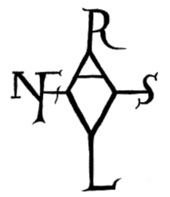Signum manus
As this symbol was used in Merovingian documents at the starting point of what would diversify into the tradition of "cross-signatures", German scholarship of the 18th century extended use of the term Chrismon to the entire field.
At the end of documents, commissioners or witnesses would sign with a signum manus, often also in the form of a simple cross.
[4] A related development is the widespread use of the cross symbol on the obverse side of early medieval coins, interpreted as the signum manus of the moneyer.
[5] The tradition of minting coins with the monogram of the ruling monarch on the obverse side originates in the 5th century, both in Byzantium and in Rome.
The signum manus in the form of a modified cross symbol first appears in charters of both Frankish Gaul and Anglo-Saxon England in the late 7th and early 8th century.



